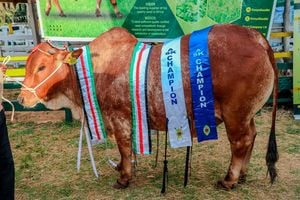
Gut oedema can be prevented in piglets by vaccinating mothers before breeding.
I had not heard from Odoto for close to a year until last week. He manages a pig farm in Kilifi County where he had a problem with crows.
The birds would patch on his pigs any time they had wounds. They would peck on the wounds, causing severe pain and discomfort to the animals and infection.
The crow is a scavenger. The bird feeds on food leftovers in garbage in the open.
Most of the material crows feed on is rotten. It, therefore, contains lots of infective micro-organism that the crows would then transmit to the pigs when feeding on wounds.
When Odoto had called about the crows, I had explained to him his problem was an invasive species of birds, poor hygiene and poor bio-security.
The poor hygiene had arisen from the fact that he and his workers had been disposing dead piglets and domestic waste inappropriately.
The birds had discovered the presence of the waste as a source of food.
The pig sheds were not secured against birds and other species entering through the open ventilation spaces between the stone wall and the roof.
The birds had come to realise that there was easier fresh food in the pigs’ wounds. On a large pig farm, there will always be some animals with wounds due to fighting, injury or skin infection.
We had resolved the problem by covering the open spaces with small-gauge mesh wire and keeping the doors to the pens closed at all times.
Second, I advised Odoto to secure garbage dumps and ensure the birds had no access. Third, I advised the farm to deeply bury dead pigs and placenta. Short of poisoning or other methods of killing, the best way to chase animal vermin is to deny them food.
When predatory or scavenger birds are denied access to food, they fly away to feed elsewhere.
One must maintain the effective measures applied because laxity would bring the birds back or attract new ones.
Odoto’s call was about foot and mouth disease on his farm, in his opinion. He is not a paravet or veterinary doctor but has worked with pigs for years. He said his healthy piglets were dying in large numbers.
The animals would show poor appetite, then increased breathing, tremors and then die.
Many of the piglets and some adults had wounds on snouts and feet. He thought he had foot and mouth disease on the farm.
He had been advised by another farmer to wash the pigs with Magadi soda solution and get a paravet to inject the pigs with antibiotics.
I reminded Odoto that it is always good to report to an animal health service provider signs of illness that a farmer observes and not give an opinion on the disease affecting the animals.
Most of the signs in animal diseases are similar but there are specific signs and parameters a doctor or paravet would look at and diagnose a disease fairly accurately.
I also reminded the manager that he could not suspect a disease, decide the treatment and then call a paravet to treat the animals according to his (Odoto’s) suspicion and proposed treatment because the paravet was the professional.
Many farmers and farm managers make the mistake of believing that after living with animals for long, they can diagnose and treat diseases. Many do so and end up incurring heavy losses.
Others end up feeding people with chemicals in the meat, milk and eggs, thereby exposing consumers to drug residues and endangering lives.
I requested Odoto to send me photos and video clips of sick and some dead pigs. I observed some pigs and piglets had pink, whittish and black wounds on snouts.
Two also had wounds on the feet, just above the junction of the hoof and skin. Some pigs had swollen faces and puffy eyes.
Most of the dead piglets in the photos were in good body condition. One was captured vomiting yellow material while others had whittish-yellow diarrhoea.
Some pens had dirty stagnant water and two pigs were snouting through the water. Both had muzzle wounds.
I already had a diagnosis on the problem with Odoto’s pigs. The wounds were caused by bacterial infection. The illness is called necrotic rhinitis. The most common cause of such wounds in pigs is a bacterium called Fusobacterium necroforum.
The bacteria are present in the environment. During feeding and snouting on the ground and in dirty water, the bacteria get into the mouth of the pigs where they become part of the mouth ecology.
When the pigs get injured, the bacteria get into the tissues and cause the ugly wounds seen in Odoto’s animals.
The same may happen to injuries in the feet or even on the skin. I advised on the antibiotics to be used and instructed Odoto to ask his paravet to get in touch with me for more discussion on the matter.
I diagnosed gut oedema in the dead piglets and those with tremors and poor appetite. This is caused by a type of bacterium called enterotoxigenic Escherichia coli.
It is a rare type of bacteria but common in piggeries. It produces toxins in intestines.
The toxins cause swelling of the intestinal and stomach walls, hence the name gut oedema for the disease the bacteria cause. Oedema is swelling caused by fluid.
The toxins are distributed throughout the body by blood and cause many signs such as the tremors, lack of appetite, swelling of the face and eyes, pneumonia and bleeding in the organs.
It also causes vomiting and diarrhoea. Most affected piglets die or get stunted for life.
I again concluded to Odoto that he had a hygiene problem. The pig pens should be kept clean dry and disinfected regularly.
Gut oedema can also be prevented in piglets by vaccinating mothers before breeding and before they give birth.









